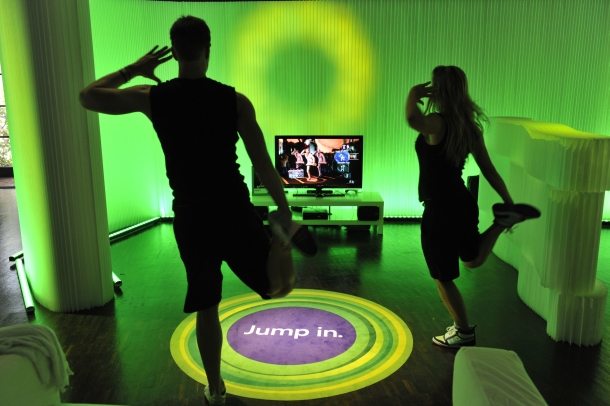Now, while Wii and the Move are, at their core, similar products (if separated by a few years of development), Kinect is very different in terms of its interface and its machinery. So, any such technological comparison is going to be moot -- however, we can compare functionality. Or, more accurately, the success with which each of these devices achieves the goals that they all share: integrating motion into the gameplay experience, and changing the way games are played.

People having fun.
First among these is ease of adoption of the new control system. We can all thank the Wii for reducing the learning curve when it comes to motion controls, and the Wii MotionPlus controller simply adds a new layer to the control scheme that so many soccer moms are already used to. These improvements are, namely: giving the Wii the ability to track rotational movements, as well as a more tightly tuned accelerometer to track speed of motion a bit better than the standard Wii Remote does. For its part, the PlayStation Move is also easy to pick up and play with -- mostly due to the inroads the Wii has made in this area. In fact, due to its Z-axis tracking and hyper-accurate sensor package, the Move is even more intuitive and easy to learn than Wii is... and offers a wider variety of control options, to boot.
Kinect, however, is another kettle of fish. First, it demands not only an entirely new style of control (using body movements), but requires a lot of physical changes to your gaming space that the Wii and Move don't. For example, Kinect needs (at minimum) a six-foot square for you to move around in, and it's gotta be completely bereft of furniture and other obstructions (including other people). It also has trouble with the kinds of intuitive, one-to-one motions that Move does so well -- oftentimes, you've got to exaggerate your motions to make sure the Kinect gets the idea, and this can be very frustrating in games that require quick reflexes. It also lacks the force feedback (and sense of physicality) that a controller has; this is not bad per se, but it takes some getting used to.
Ease of Adoption Winner: PlayStation Move. It capitalizes on the groundwork laid by the Wii, and makes the motions even more intuitive.

People having more fun.
Since each of these control schemes is ostensibly designed to bring us together in a group with our buddies/significant other(s)/dudes off the street, another major factor in comparing them is how well they handle party gaming. You'd think Kinect would be the obvious winner here, what with all the ads showing those shiny, happy people jumping around and smiling and stuff. Unfortunately, Kinect's ability to track multiple people at once is pretty poor; playing with a friend leads to the machine losing where each of you are at any given time, and therefore constantly interrupting the action in order to reacquire you. It also requires a gigantic area of free space, even more than the Kinect does with a single player. So, unless you live in a warehouse or have a full-time set of furniture-movers as roommates, you're going to have a hard time getting any kind of party gaming going on with Kinect.
As for the Wii MotionPlus, it has the ultimate advantage here because its game lineup is so wide -- and after several years, it ought to be. Neither Kinect nor Move have anywhere near the lineup of quality titles, much less ones that have been optimized for multiple simultaneous players, as the Wii does. Moreover, while Move is a more accurate and versatile control system than MotionPlus, without the stable of software to employ its skills on, that's pretty much a moot point. While the Wii's time advantage isn't easy for these new peripherals to combat out of the gate, it's definitely a factor for social gamers to consider.
Party Gaming Friendliness Winner: Wii MotionPlus. The MotionPlus's additional controller capabilities enhance the games you already know and love.

People having the most fun.
Finally, you should take the practicalities into account. The Wii's MotionPlus controllers are an add-on for the controllers that already came with the system -- a package deal that has little additional cost or learning curve. Move and Kinect, by contrast, are honest-to-goodness peripherals that need to be purchased separately. Although Move is theoretically cheaper on an a la carte basis, buying enough Move controllers to accommodate two people, plus the Move Sensor, is going to run you a pretty penny. In the long run, Kinect -- while it's currently almost as expensive as a freakin' Xbox 360 itself -- is ultimately cheaper, as you don't need to buy a lot of separate peripherals to use the sensor. Hell, you might even save money in furniture costs when you strip your apartment down to bare floor as you make enough room to play.
The PlayStation Move comes in a package bundle with one sensor and one Move controller (and the pack-in Sports Champions game), for $100. Further controllers run $50 a pop, not counting the $30 Navigation controllers (the Move's equivalent of the Wii Nunchuk), chargers, etc. Kinect costs $150, and requires extra power, so it'll put a slight hit on your power bill to boot, but that's all you have to deal with. The Wii MotionPlus add-on is $25 (or $40 if you want to buy the entire Wii-mote bundle, and $20 for extra Nunchuks) -- plus the Wii itself is still cheaper than either an Xbox 360 or a PlayStation 3. I think this one is pretty clear.
Wallet Pain Level Winner: Wii MotionPlus. The math don't lie.
From the perspective of doing what it's actually supposed to do, the Kinect isn't really all that impressive. Move easily has the best technology, but that doesn't mean it's the best use of your money, as you need to have something to use the technology on. So, after all this rigmarole, the fact is, the original gangsta -- that is, the Wii -- is still the way you're probably going to want to go for your party-time video gaming needs.





